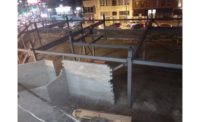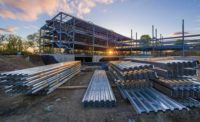Trade war! What is it good for? Whether absolutely nothing or something else, construction will start to find out March 23 when a 25% tariff on imported steel and a 10% tariff on aluminum proposed on March 8 by President Donald Trump takes effect.
Trump had to act by April 11 and April 19, respectively, to impose them under national security provisions in Section 232 of the U.S. Trade Expansion Act based on U.S. Commerce Dept. reports sent to the White House in January. Of proposed options that included quotas and tariffs on all foreign imports, Trump chose tariffs on all countries, with the exception of Canada, the largest exporter of steel into the U.S., and Mexico, the fourth-largest steel exporter. The result could simply divert steel from high-tariff countries to North American producers.
Commerce hopes to raise domestic steel capacity use rates from their current 73% to 80%. “As domestic structural steel and reinforcing-bar producers increase capacity, they will be able to raise prices close to the limits set by the tariffs,” says John Anton, steel analyst for IHS Markit. But prices were already on the rise, he says, predicting that domestic structural steel prices will increase 13% in the first quarter of this year to $734 per ton, to be followed by a 10% hike in the second quarter before peaking at $817 by year end. “These are significant price increases and could threaten budgets for steel-intensive projects,” Anton adds.
Already, costs for many materials are spiking. The Bureau of Labor Statistics producer price index in February posted annual increases of 38.7% for diesel fuel, 17.1% for plywood, 15.6% for softwood lumber and 10.1% for aluminum. The PPI for copper products, however, fell to an annual rate of 8.9% in February, down from a 17.5% annual rate in January.
Rebar pricing is set to follow a similar path as structural steel. Anton sees rebar prices up 9% in the first quarter and another 20% in the next, to $737 per ton, with prices easing by the second half of 2018.
Trucks and construction machinery will also face rising price pressure, based on IHS’ latest forecast. It calls for hot-rolled coil prices to jump from $743 per ton this quarter to $881 by the second quarter. Hot-rolled coil prices should start dropping in the first half of 2019, Anton says. Infrastructure projects using plate, cut to length, will see a similar price hike, from $789 per ton to $922 over the same period, according to IHS.
As it has done for steel, China has used government subsidies to greatly expand aluminum production in the last few years, says John Mothersole, IHS Markit economist. This has pushed Chinese products into export, putting pressure on domestic producers, he says. Domestic capacity utilization in the aluminum sector is less than 40%. “There have already been three [U.S. plant] restarts announced, so one of the intended goals of the tariffs, the revival of the primary aluminum smelting industry, appears to be having some impact,” says Mothersole.
As a result, he predicts much of the 10% tariff on aluminum imports to translate into higher prices later in 2018, including bumped-up prices for aluminum mill shapes and extrusons, a 12.7% increase by year end. Without tariffs, Mothersole thinks the price hike would be just 3.4%. Aluminum die castings will be less affected because of their high scrap content, but annual price hikes are set to average 9.2% by the fourth quarter. Before tariffs were announced, Mothersole had been looking for only a 0.2% increase for this category.





Post a comment to this article
Report Abusive Comment